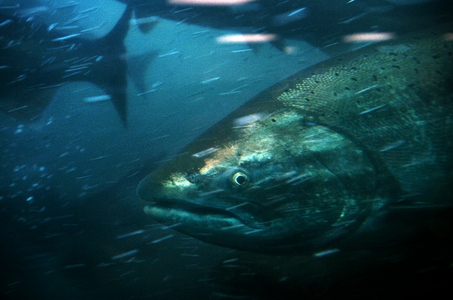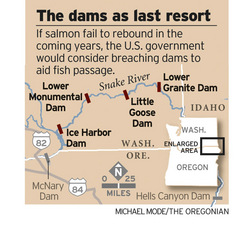forum
library
tutorial
contact

Obama Speeds Effort to Save Salmon,
Renews Dam-Removal Option
by Matthew PreuschThe Oregonian, September 15, 2009
|
the film forum library tutorial contact |

|
Obama Speeds Effort to Save Salmon,
by Matthew Preusch |
 The U.S. government wants to do more to save Northwest salmon, and faster. And if that doesn't do enough for the imperiled fish, it will consider breaching one or more dams on the Snake River in Washington, sacrificing power production to help fish swim to and from the sea.
The U.S. government wants to do more to save Northwest salmon, and faster. And if that doesn't do enough for the imperiled fish, it will consider breaching one or more dams on the Snake River in Washington, sacrificing power production to help fish swim to and from the sea.
The approach announced Tuesday by the Obama administration for the Columbia River basin's 13 federally protected runs of salmon and steelhead largely continues a course set last year: Improve river and habitat conditions for fish throughout Oregon, Washington, Montana and Idaho, and help them safely pass the dams.
Significantly, the plan doesn't call for removing any dams. But it does restore a Clinton-era provision that was deleted by the Bush administration to open that possibility should the fish slip closer to extinction. Electricity ratepayers in the Northwest have paid most of the roughly $1 billion spent annually in helping the signature species.
The government's intentions Tuesday were hailed as unprecedented by some but mocked by others as a continuance of failing efforts. The state of Oregon said it was disappointed in the White House's review.
The administration's most important audience, however, is a federal judge in Portland who has rejected past federal blueprints to save the fish and must decide whether this one rises to the requirements of the Endangered Species Act.
Earlier this year, the administration asked U.S. District Judge James Redden for time to review the Bush-era plan before deciding whether to support it. On Tuesday, it said it would.
Most efforts to offset challenges to salmon have centered on habitat restoration, extensive hatchery operations, barging of young ocean-bound fish around dams, and attempts to provide ample cool water for fish while meeting the demands of farms and growing cities.
But in saying it wanted to continue such efforts, and do so faster, the Obama administration added an "insurance plan" that spells out what it will do -- or consider doing -- if salmon, at a fraction of their historic numbers, fail to rebound.
In some instances, that could mean sharply curtailing fishing or taking more aggressive actions to improve water flows at dams. At the extreme end, it could mean dam removal.
"We believe the actions in the plan will prevent further declines, but we've added these contingencies just in case," said Jane Lubchenco, the Oregon marine biologist who heads the National Oceanic and Atmospheric Administration.
"Possible breaching of the Snake River dams remains on the table in this plan, but it is considered a contingency of last resort and would only be implemented if the analysis concludes it would be appropriate and, in fact, beneficial," Lubchenco said.
The government's approach, said Lubchenco, acknowledges scientific uncertainties in trying to mount the largest wildlife rescue endeavor in U.S. history.
"I don't think that it's problematic at all to say we don't have all of the knowledge that we'd like to have," Lubchenco said. "Some things are too new."
One Washington congressman criticized the administration for re-energizing the debate over dam demolition, an issue that has spanned many governors and U.S. presidents.
"It is such a sad, terrible waste that this battle is being reignited, but let there be no doubt that we'll fight to save our dams in every way we can. These dams are here to stay," said Rep. Doc Hastings, whose district includes one of the dams.
 But the dam removal provision in Obama's plan released Tuesday is just "an illusion," Samuel N. Penney, chairman of the Nez Perce Tribe, said in a statement. The tribe, along with the state of Oregon and a coalition of salmon groups, is challenging the plan in court.
But the dam removal provision in Obama's plan released Tuesday is just "an illusion," Samuel N. Penney, chairman of the Nez Perce Tribe, said in a statement. The tribe, along with the state of Oregon and a coalition of salmon groups, is challenging the plan in court.
"I'm not sure Mr. Hastings should worry himself so much," said Nicole Cordan, attorney for Save Our Wild Salmon.
As it reviewed the salmon plan this summer, the Obama administration largely ignored the concerns of Oregon and other critics, said Mike Carrier, Gov. Ted Kulongoski's natural resource adviser. Those concerns centered on maintaining river flows to aid fish.
"The things that we've suggested continue to be absent from this plan," Carrier said.
The administration's decision Tuesday to largely uphold the Bush-era blueprint breaks with a pattern from recent months in which federal reviews of Bush environmental policies resulted in their being overturned.
Bush's relaxation of rules governing roadless forests, spotted owl habitat and logging in western Oregon's federal forests has been tossed out.
But when it comes to Columbia basin salmon, "I would say the new guys in town look a lot like the old guys in town, and I don't know if that's enough for Judge Redden or not," said Michael Blumm, an environmental law professor at Lewis & Clark whose former students are involved on both sides of the court dispute over the plan.
The plan released Tuesday promises an additional $40 million for 21 habitat projects in the river estuary, where the massive Columbia meets the sea.
It also ramps up research on how fish are responding to recovery efforts, commits NOAA to building a new mathematical model to predict salmon population trends, and looks more deeply at the role predators and non-native species play in salmon survival.
Steve Wright, administrator of the Bonneville Power Administration, which funds most of the salmon projects, said the administration's adjustments to the plan would cost an additional $6 million a year on top of the roughly $100 million it already costs to implement.
"We have hopefully reached the end of a long litigation road presided over by this court for nearly a decade, spanning two prior administrations," U.S. attorneys wrote in their court filing Tuesday.
Excerpts from Adaptive Management Implementation Plan (AMIP): bluefish text in red
By March 2010, the Corps in coordination with NOAA Fisheries and the other Action Agencies will complete a "Study Plan" for breaching of lower Snake River dams. The Study Plan will detail the scope, schedule and budget to conduct and complete technical studies and decision-making process, including the following:Dam breaching technical studies identified in the Study Plan would be initiated by the Corps if one of these three conditions applies:
- Aquatic ecosystem effects (e.g., resident fish, biological analysis of anadromous fish using results from life-cycle model analyses, potential changes in hatchery and habitat programs, and other additional relevant technical evaluations)
- Socio-economic effects (e.g., hydropower replacement, navigation, recreation, etc.)
- Other environmental effects (sediment, water quality, air quality, etc.)
- Additional engineering analyses (e.g., rock source explorations for rip-rap, and additional modeling of the by-pass channel)
Triggers:
- an All-H analysis, including life-cycle modeling results, identifies lower Snake River dam breaching as necessary to address and alleviate the biological trigger conditions for the applicable Snake River species (Idaho's Sockeye are specifically excluded);
- the analysis is sufficiently inconclusive to identify what actions are necessary to address and alleviate the biological trigger conditions for the applicable Snake River species; or
- the analysis is not completed within six months of the biological trigger being tripped, with a completion goal of four months.
Beginning with the availability of 2009 data, NOAA and the Action Agencies are establishing:Issue Resolution Process
- An Early Warning Indicator: This indicator will alert NOAA Fisheries and the Action Agencies to a decline in a species' abundance level for natural-origin adults that warrants further scrutiny because it indicates that a Significant Decline (see below) may be reached in one to two years. The indicator for each species will be a running four-year mean of adult abundances that falls below a 20% likelihood of occurrence.
Within 120 days of NOAA Fisheries' determining that the Early Warning Indicator abundance levels have been observed, the Action Agencies, in coordination with NOAA Fisheries, the RIOG, and other regional parties will determine whether the species in question is likely to decline to a level that will trip the Significant Decline Trigger. This evaluation will be based on additional indicators and predictors of status (e.g., jack counts, ocean conditions, and habitat disturbances). If the early implementation of Rapid Response Action(s) is warranted, the evaluation will determine which actions to take. The Action Agencies will implement the Rapid Response Actions as soon as practicable, but no later than 12 months from the date the indicator is observed.
- A Significant Decline Trigger: Each year, the federal agencies will check for a significant decline in the natural abundance of the species. A significant decline is judged to occur when the running four-year mean of natural-origin adult abundance falls below a 10% likelihood of occurrence based on historical data (see Appendix 4, Table 1 for these thresholds). The principle underlying the Significant Decline Trigger is that these thresholds represent significant deviations from the biological expectations in the 2008 BiOp.
Within 90 days of NOAA Fisheries determining that the Significant Decline Trigger has been tripped, the Action Agencies, in coordination with NOAA Fisheries, the RIOG, and other regional parties will determine what Rapid Response Actions to take. The Rapid Response Actions will be implemented as soon as practicable, but no later than 12 months from the date the trigger is tripped. Rapid Response and Long-term Contingency Actions will be periodically reviewed to determine whether the actions continue to be necessary and if so, whether alternative actions might be more beneficial.
Concurrent with the initiation of efforts to determine what Rapid Response Actions will be taken, the Action Agencies will initiate an All-H Diagnosis informed by life-cycle modeling of potential Long-term Contingency Actions. Within four to six months after the Significant Decline Trigger is tripped, the Action Agencies (in coordination with NOAA Fisheries, the RIOG, and other regional parties) will complete this analysis and determine if the Rapid Response Action(s) are likely to be sufficient or if Long-term Contingency Actions (other than lower Snake River dam breaching, see below) will need to be implemented and if so, what Long-term Contingency Actions will be implemented. If necessary, those Long-term contingency actions will be implemented as soon as practicable.
Decisions about the development of the Significant Decline Trigger and Early Warning Indicator and whether the trigger or indicator have been tripped or observed are ultimately the responsibility of NOAA Fisheries. Decisions regarding the implementation of Rapid Response and Long-term Contingency Actions are the responsibility of the Action Agencies. However, the federal agencies will endeavor to continue to use collaboration with regional sovereigns and stakeholders to address issues before any decisions are made and to work collaboratively within the federal agencies to assure decision-making is coordinated. Where there are disputes between the federal agencies that are not resolved regionally, or as in the case of lower Snake River dam breaching where significant national issues are at stake, issues will be elevated to the Administration and resolved at the appropriate level.
learn more on topics covered in the film
see the video
read the script
learn the songs
discussion forum
